I am working to convert my ACE Mini-Titan e325 to a night-flying setup. Since Winter is on the way, the only time I’ll be able to fly is later on in the day when the sun is low, or gone, so this is a perfect excuse to play with LED lights. LED Technology had come a long way in recent years so they’re both affordable and available in numerous color and brightness variations. I have looked at the neon type lighting, the electroluminescent (EL) wire, before and while it’s cool, it’s not quite the direction I’m going at the moment. The neon type lighting is much more flexible so if you’re trying to conform your lighting in fine lines around curves and such it might be a good option. Either way, solid state lighting has opened up a lot of options for hobbyists trying to light their nights up.
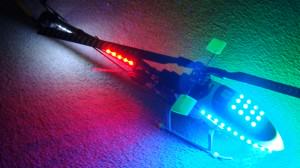
I purchased 2 feet of green and blue LED strip lighting from a vendor at the 2010 NEAT Fair while purchasing a Blade mSR and some extra batteries for it. The LED strips are basically a linear LED array which can be cut down to sections consisting of 3 LEDs minimum and require a 12 volt power supply. LED strip lighting can also be found that will run on a 5 volt power supply. The 12 volt powered strips work great on radio controlled models which use 3S Lithium Polymer battery packs. Because LEDs are low power draw, even a lot of LEDs won’t make for a huge impact in your flight times if you run them off of your main flight pack.
LEDs are light emitting diodes, because they are a diode they will only conduct current one way, you will not hurt them by hooking them up backwards, they simply will refuse to light, if a strip light fails to power on for you, double check your power supply polarity first.
In my setup I use a male JST style connector on the canopy which makes connecting and disconnecting the LEDs for the canopy a simple and quick matter. The female JST connector’s wires run to and tie in with the power lines which run the helicopter tail boom lighting. These are connected to the power connector for the brushless motor speed controller.
The LED strips come with an adhesive 3M tape backing which will pretty much stick to anything. To prep the Mini Titan canopy I scrubbed it down with 90 percent rubbing alcohol, then i scrubbed it down again and wiped it down, then one more time for good measure. I spent a little bit of time placing strips on different locations of the canopy and finally decided on a layout for the LED strip lights. Once set I cut the strips down to length for each location, removed the paper tape from the adhesive backing and then pressed the strips onto the helicopter canopy.
Once all the strips were down I soldered on all the wiring to connect the LED strips to each other. Soldering LED strips isn’t that hard to do with the right equipment and experience but if you haven’t soldered before I’d recommend practicing your soldering skills a lot before attempting this. There are exposed solder pads at each end of every set of 3 LEDs on the strip which allows you to solder the strips in parallel to each other. I was a bit concerned that soldering the tape while it was stuck to the canopy would melt the canopy at points, but it is a thermoplastic and did not have any problems with the short soldering times required. I used a 45 watt soldering iron to first prime the pads with a blob of solder, and tin the ends of the bridging leads, I then placed the tinned wire atop the hemisphere shaped blob on the soldering pad, heating both till they fused then let the joint cool normally. The last step of the soldering process takes about 2 seconds. You can see the pads in detail in the pictures below, and also how I routed the wires around and took advantage of solder pads being everywhere on the LED strip lighting. Just mind your polarity and you will be good!
That’s all there was too it. It took me about 3 hours last night to do all the work, but that was while watching TV and occasionally plugging the strips in after each addition to make sure everything was still working good and that I had not created any solder shorts which would cause unfortunate problems on the electrical system and batteries for the helicopter.
The results of this work are pretty good and can be seen in the photos below. You’ll also see I have some red and white LED’s in the back. I am planning to replace these with longer strips of alternating colors (red/white or purple/white) perhaps helical wound around the tail boom so I did not detail the installation of these, though it’s pretty much the same; Clean, place and solder. I also have a 1 Watt green Luxeon Star in the front mounted inside of the canopy. The Mini-Titan’s battery tray almost perfectly fits an old square style Luxeon Star board and with the LED right in front of a canopy vent it gets plenty of fresh moving air which means I didn’t have to add any additional heatsinking for the LED.
The setup is very bright, we took some video of it tonight and it over drove the video camera. I didn’t mess around with the video camera’s settings too much but I’m sure it could have been adjusted to better tone down the lights. While the lights are extremely bright in person as well, they are also well defined and don’t turn into a ‘glowing glob’. Here’s the short video I made of this setup.
A couple days later: I managed to get the Mini-Titan out in the field today to test the canopy lighting with a little night-flying and see how the LEDs looked. The camera adds a lot of light to the scene as it increases the gain. It does very well in low-light situations, although it was quite dark it was not technically ‘night’ but maybe 20 to 30 minutes after sunset. I would say that the LED strips certainly did the job. I am thinking of using different color LEDs on top of the canopy because the blue and green stripes are not so obvious when you’re flying. I may try some red or yellow strip LEDs instead to provide some contrasting colors, there may also be some more exotic options.
LED Strip lighting can be bought from a lot of places online. It’s cheaper if you buy a full spool and just cut off what you need, and maybe you can resell some of it at your club or trade it with your friends or use it for different night-flying projects. These are bright enough you could even do some accent lighting in your home are car with the extras!
One place I found to be reasonable is ledlightsworld.com you can get their SMD 3528 spools for $65.95 each which gets you 16.4 feet of LED’s at $4.02 per foot. Their LED Strips come in Pure White, Warm White, Red, Green, Blue and Yellow. These spools below come with 300 LEDs per 16.4 foot roll, and you can get them in a super bright 3-chip version with 150 LEDs per 16.4 foot roll, or a high density version that has 600 LEDs per 16.4 foot roll. They also sell these tapes with side emitters so for planes you could put them on the back edges of ailerons and other control surfaces or stack them for a layered effect! Lots of different things to experiment with. LED world also sells these spools by the foot, but you loose the bulk discount, and it may be cheaper just to buy them from a third party ‘night flying supplies’ company.
Update 5/2/2014 – A note on pricing
Pricing on things change a lot, and it certainly has for LEDs. Check eBay for current pricing on LED strips. I just picked up 4 full length spools of 3528 Red, Green, Blue and White LEDs for $10/each including shipped last week and they’re great, I’m glad the prices have dropped so much!
As usual I get part way into a project and I have a great idea when I start seeing the other products available. The same company also sells a variety of RGB LED strip lighting. With the first type the LEDs along the whole length of the LED strip can be driven with Red, Green and Blue input lines by varying the voltage input to them. So with an something like an Arduino you could use 3 PWM (Pulse Width Modulation) outputs to drive transistors which drive the 3 lines, producing a large variety of colors along the whole strip and do things sort of what like you see in this video of RGB LED strip lighting below from AACstyle on YouTube.
And then I was looking a bit more, and they actually sell RGB LED strip lighting where each LED has it’s own controller chip for RGB color mixing, this means that you can individually access each LED on the strip and set the color to one of millions if not trillions! That’s pretty awesome. Of course you’ll need a micro-controller to do the RGB mixing and send the proper control signals. I don’t have the exact specifications on the control signals other than the visible 5v, L, Clock Data, D and GND markings on the strip but it’s either an addressable system, or more likely, a shifted bit register sort of like the MaceTech RGB *Brite LED Modules (ShiftBrite, MegaBrite, Etc)
You can see the RGB LED driver chip in this close-up photo of the LED strip light that controls each LED. It’s the black module between the two white RGB LED chips. This is probably a TI or ST LED driver IC but I can’t see the chip close enough to tell, also possible a Chinese made clone chip. Also the LED chips appear to be through-hole LEDs and not SMD LEDs like you see on the other LED strips.
Seeing this kind of thing gets me all excited about the creative ideas which are possible with this kind of lighting. You could use an input on the micro-controller to sample the PWM signal from one or multiple servos and use that data to alter the coloring of the strips. If you put them on a plane you could have the ailerons shift colors as they’re moved, as well as the elevator and rudder, plus change the whole color of the fuse as you move the throttle. Add an altitude or airspeed sensor onto your micro-controller and you can provide even more variations or effects.
Here’s a video of this type of chip driven RGB LED strip light in action, it looks pretty amazing. And pretty, and amazing too.
Indeed some companies offer LED lighting systems for radio controlled models which change colors and shift colors along the whole strip, but I’ve not seen one with individually addressable LEDs and they may not see a reason for doing that or it may be out of the price range of the standard hobbyist. Maybe there isn’t a good reason to do this and I’m just geeking out on color LED lighting for model aircraft and uses for some of micro-controllers.
Unfortunately a 16 foot strip of these LEDs cost $320US (5/2/2014 – That’s outdated pricing, they’re much cheaper now), which is expensive, but reasonable for the configuration. I put a bunch of these on my Y-6 multicopter and connected them to an accelerometer to change color and speed based on vertical climb rate.
Update 5/2/2014
Since I wrote this post, the prices on LED strips have dropped quite a bit. The smart strips with driver chips have come down by a huge amount as well. I find eBay is a great place to buy a lot of these products since the competition is very high and the prices are very low. Many of them do get shipped from overseas (China, etc) and will take anywhere from 1-3 weeks to receive, though I have found some good prices shipped from the US with fast shipping.
These days there are some other options out there for ‘smart’ LEDs as well. Ws2812B LED strips can be had and they only require 4 wires and some fairly accurate timing to drive them properly. Fortunately there are libraries out there for Arduinos already, so most of the ‘heavy lifting’ for driving these LEDs is taken care of. Here’s an 8×8 pixel array I made with these WS2812B LEDs
They also come in strips just like normal LED strips which is better for our R/C model use, and you can find drivers for them as well, go to Adafruit and check out their ‘NeoPixel’ products, NeoPixel is just Adafruit’s name for the ws2812B and you may find them cheaper somewhere else, but they provide a lot of tutorials and hardware to drive them, and they come in different shapes like rings, so it’s not too bad to support companies who share with the community.
Check out my other posts on LEDs, you can use the search functions on the page to search for LED and a bunch of stuff will come up.
Please let me know what you think of the canopy setup for this helicopter, or share some info on your own setup by commenting below or using the contact form to send me a personal message. Also if you have any cool ideas feel free to share them by commenting below.

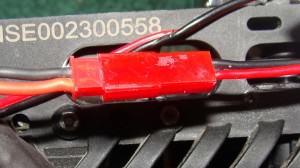
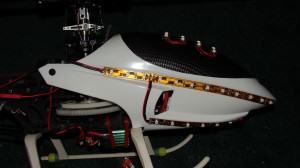
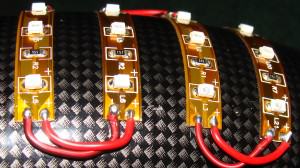
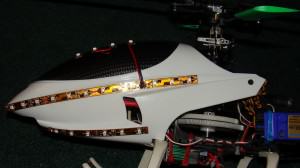
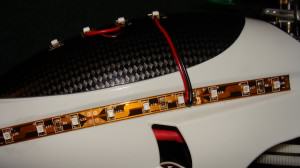
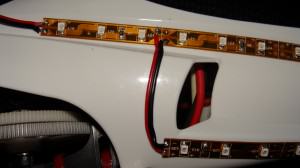
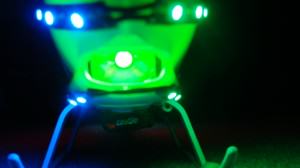
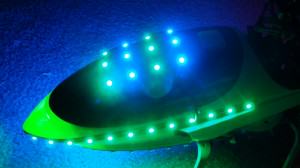
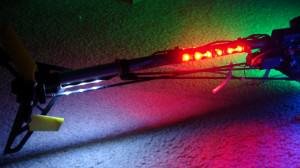
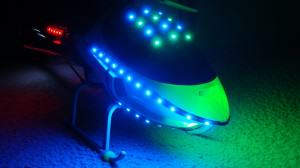
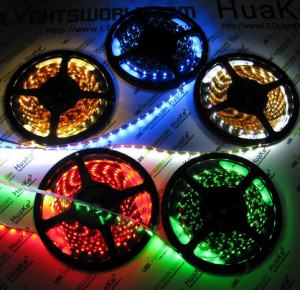
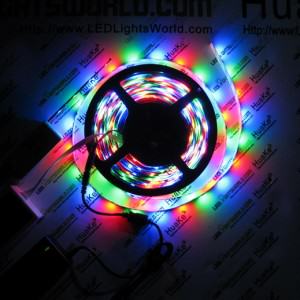
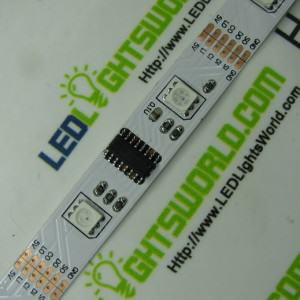
9 responses to Mini-Titan e325 Night Flying LED Lights Setup Progress
Thanks for the idea! I ordered some LEDS off eBay for a few dollars each and made something very similar! Excellent for late afternoon flying and looks pretty cool too.
I’m glad you found the page useful. I’ve been flying multirotors more and more and the LEDs sure help a lot with the orientation of those things too. The prices for basic LED strips are really cheap now. I just ordered a bunch at $10USD for a 5 meter strip with 150 LEDs per meter to light up the insides of some foamy planes and for the arms on the new tri-copter.
Hi by any chance can they be used in planters
They have moisture resistant versions. The top surface over the lights is basically weatherized with a clear rubber material. I am certain there are fully weatherproof versions out there if you do a bit of research though. If you can’t find one though, you could put the LED strips inside of clear acrylic tubes or square stock and just seal the ends with silicone or something else.
thank you 4 your time
where did you get your leds i need some like that just yellow, blue, and purple…
Hi there cosplayer, I got mine at the NEAT fair in NY, but you can buy them from a variety of hobby vendors or just plain LED vendors. For R/C vendors check some of these places:
http://www.hobbyking.com/ search “LED Flexible strip”
http://www.amainhobbies.com/ look for “Common Sense RC LED Light Strip”
If you’re having trouble finding the colors you need check out http://www.ledlightsworld.com/ as well or do a search on Google for LED light strip. Good luck.
Hi there:
You may want to use led strip with a white PCB so your canopy does not look funny in daylight. See here for example:http://www.solidapollo.com/led-strips/.
That’s a nice setup, thanks for sharing how you did it.
Mini-Titan e325 Night Flying LED Lights Setup Progress 1 Trackbacks / Pingbacks
Making Night Blades for R/C Helicopter | Jon's Hobbies Comment on Mini-Titan e325 Night Flying LED Lights Setup Progress (September 11th, 2011 at 22:11)
[…] learned quite a bit in the last few years so I believe it will be a fun project. If you saw my previous post on lighting the mini-titan you saw my discussion of a lot of LED strips which are available. Those will get used for the main […]
Leave a reply to Mini-Titan e325 Night Flying LED Lights Setup Progress